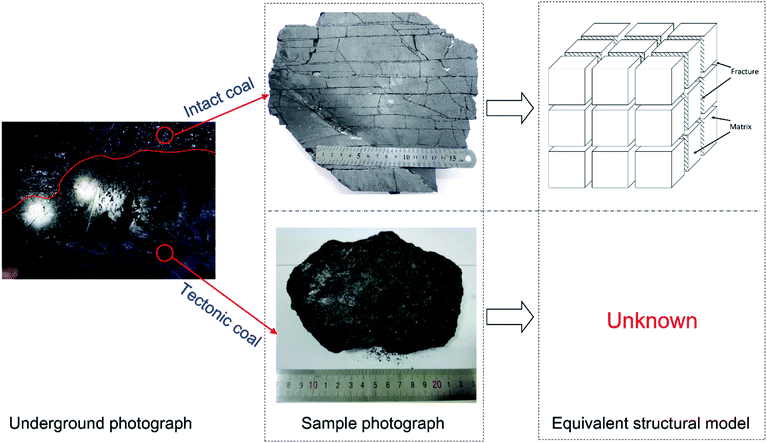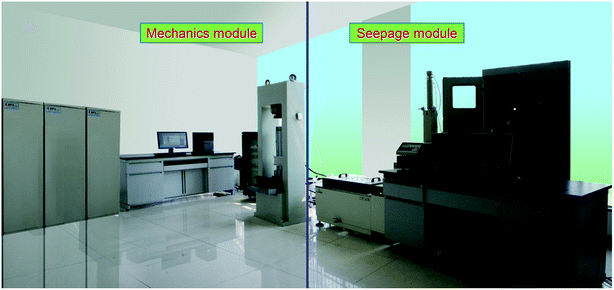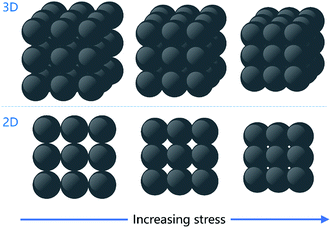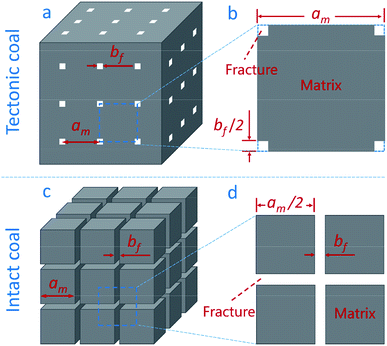 Open Access Article
Open Access ArticleEstablishment of the equivalent structural model for the tectonic coal and some implications for the methane migration
Jun Dongabcd,
Yuanping Cheng b,
Liang Wang
b,
Liang Wang *b and
Pinkun Guoacd
*b and
Pinkun Guoacd
aCollege of Safety Science and Engineering, Nanjing Tech University, Nanjing 211816, China
bKey Laboratory of Gas and Fire Control for Coal Mines (China University of Mining and Technology), Ministry of Education, Xuzhou 221116, China. E-mail: liangw1982@126.com
cJiangsu Key Laboratory of Hazardous Chemicals Safety and Control, Nanjing 211816, China
dKey Laboratory of Safety Production of Chemical Process (Ministry of Emergency Management), Nanjing 211816, China
First published on 6th March 2020
Abstract
The establishment of the equivalent structural model (ESM) is the foundation to simplify the structures of the coal matrix and fractures for the study of methane migration. The ESM of the intact coal has been proposed and widely used by many scholars, but the ESM of the tectonic coal has not been found in the literature. The application of the ESM of the intact coal to the tectonic coal is not reasonable for the study of the methane migration properties, so the establishment of the ESM for the tectonic coal is necessary and meaningful. In this study, a tectonic coal specimen was remodeled from collected coal powders, and methane permeability tests were conducted. Then the ESM of the tectonic coal was established by analyzing the fracture structure. The results show that the tectonic coal can be idealized as a model containing a cubic matrix with square section fractures located at the twelve edges of the matrix. Because of the variation of the ESM, the permeability and the fracture porosity has a square relation for the tectonic coal, rather than the cubic relation for the intact coal. The matrix shape factor of the tectonic coal has also been proposed, which has a value of 480bf/7a3m and is much smaller than that of the intact coal.
1 Introduction
Coalbed methane, as a byproduct of coal, is an abundant, clean, low-cost and high-energy resource that has been widely used for electricity generation and domestic fuel.1–3 Methane is also a powerful greenhouse gas with a global warming potential (GWP) 34 times greater than carbon dioxide over a 100 year time period.4 In addition, due to its flammable and explosive properties, methane can be the cause of serious disasters that kill hundreds of people every year in China. Methane extraction not only can obtain clean energy but also weaken the greenhouse effect. Usually, a coal reservoir is treated as a dual-porosity system consisting of coal matrix and fractures.5 Methane migration in the coal reservoir is considered as a series of processes consisting of diffusion through coal matrix and seepage in fractures.6 Undoubtedly, a smaller coal matrix or a larger contact area between the matrix and fractures will offer a higher mass transfer area for the methane migration, which enhances the capacity of methane diffusion. Meanwhile, the fracture system with a better connectivity will improve the methane seepage capacity. For example, the methane seepage in the parallel plate shaped fractures is obviously easier than that in winding fractures. Thus, we can conclude that the structures of coal matrix and fractures have a great influence on the migration properties and extraction effect of methane in the coal reservoirs.Coal is a solid combustible organic rock, which is transformed from plant debris with complex biochemical, physical, chemical and geochemical processes over a long period of geologic time.7–10 Thus, the positional relationship between the matrix and fractures and their scale sizes are usually complicated and inconsistent. To simplify the structures of coal matrix and fractures for the study of methane migration, the equivalent structural model (ESM) of coal should be established. In 1963, Warren and Root firstly proposed the ESM of naturally fractured reservoir, i.e., the intact coal reservoir (see Fig. 1).11 This model shows that the coal matrix is a cube and its six outer surfaces contact the parallel plate shaped fractures, so this model is usually named cubic model. In 1980, Reiss proposed that the physical structure of coal can be simplified as a plate model or a matchstick model, meaning that the matrix is a sheet or a quadrilateral prism.12 When studying the methane migration, the problems of anisotropy of the plate model and matchstick model have to be treated. Thus, the isotropic cubic model has been widely used by many scholars.1,13–16
However, all the three models are established for the naturally fractured coal. In the process of coal formation, a part of intact coal was subjected to tectonism, forming deformed coal with new structural characteristics; such coal is named tectonic coal (see Fig. 1).17,18 Because of the variation of structure, the matrix may no longer be cubic, and the fractures may not be parallel plate shaped. In other words, the cubic model is not suitable for the tectonic coal. Also, the plate model or matchstick model is invalid to represent the structure of the tectonic coal. Through literature review, we have not found the ESM of the tectonic coal, and the previous study on the methane migration of tectonic coal imitates the cubic model of intact coal, which results in huge errors. In conclusion, the ESM of the tectonic coal has not been established, and the research on this subject is necessary and meaningful for figuring out the methane migration properties in the tectonic coal reservoirs.
In this study, we prepared the standard specimens of tectonic coal and conducted permeability tests. Then, the fracture structure of the tectonic coal was analyzed, and its ESM was obtained. Considering the differences of the ESMs between the tectonic coal and intact coal, this paper also discussed the variations of the permeability model and the matrix shape factor.
2 Specimen preparation and permeability test
2.1 Tectonic coal specimen preparation
To study the ESM of the tectonic coal, we firstly need to obtain the research object, that is, tectonic coal specimen with its original structure under in situ condition. The bitumite of the Qinan coalmine in the Chinese Huaibei coalfield was chosen as the research object after comparing several coal samples because it has a higher tectonic degree. The coal block is soft with unclear structure (see Fig. 2(a)) and easy to break into powders with hand. Thus, it can be concluded that the collection of coal sample accompanied by geostress unloading makes it impossible to maintain the in situ condition of the tectonic coal.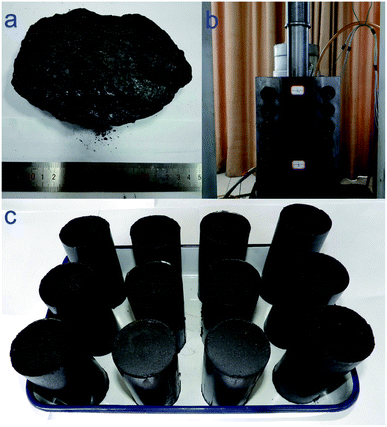 | ||
| Fig. 2 Tectonic coal of Qinan coalmine and preparation of standard coal specimens: (a) coal block; (b) secondary forming of coal block; (c) prepared coal specimens. | ||
To reconstruct the original structure of the tectonic coal, a punch machine was used to conduct secondary forming of the coal block (see Fig. 2(b)). A mold with an inner diameter of 50 mm was chosen to form the tectonic coal specimen into standard coal specimens (ϕ50 × 100 mm) for further study. Ref. 19 gives the detail method to obtain the reliable coal specimens, and the key factor is that the compressive stress is chosen to be 150 MPa. The prepared tectonic coal specimens are shown in Fig. 2(c).
2.2 Methane permeability of tectonic coal
After obtaining the tectonic coal specimen close to its original structure, we need to analyze the fracture structure because it is the key to obtain the ESM of the tectonic coal. Methane migration in the fractures is usually considered as seepage, so the value of methane permeability in coal can help to obtain the fracture structure.The transient pressure pulse method was adopted to test the methane permeability of the prepared coal specimens with an adsorption-seepage-mechanics coupling characteristic testing system (see Fig. 3). According to the Darcy's law, the permeability can be calculated using the following equation:20
 | (1) |
Two specimens were selected to conduct the permeability tests. When the effective stress is 2.0 MPa, the permeabilities are 0.0932 mD and 0.0840 mD. The parallel tests found that the permeability values of the two specimens have little differences. Thus, the obtained methane permeabilities were considered to be reliable.
3 Establishment of equivalent structural model
3.1 Analysis of coal fracture structure
The key to obtain the ESM is to analyze the fracture structure of coal. In this part, we theoretically analyze the fracture structure according to the methane permeability. It is generally considered that the coal particle is a complete matrix and the gas migration form in the coal particle is molecular diffusion.21,22 The interspace between the particles is larger in size and better in connectivity than the internal pores of the particles, which is the fracture and the gas seepage space of the tectonic coal. Under in situ condition, the coal particles are in close contact with each other, accompanied by elastic–plastic deformation and particle dislocation. The cements make coal particles have certain cohesiveness, and the unbonded parts between the coal particles can be considered to form the capillary fractures. Assuming that the capillary is a cylinder (see Fig. 4(a)), and according to the Hagen–Poiseuille's law, the permeability of gas flow through a fracture with a circular section is
 | (2) |
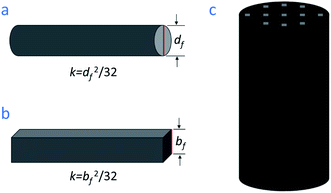 | ||
| Fig. 4 Illustration of circular section fracture, square section fracture and coal specimen with fractures. | ||
If the tectonic coal is made up of equal-diameter spherical particles with cube stacking form, the cross-section of fracture is closer to a square under compressive stress.23 When the fracture section is a square (see Fig. 4(b)), setting its hydraulic radius equals to that of a cylinder, the edge length of the square section fracture bf is equal to the diameter of the circular section fracture df. Thus, the permeability of gas flow through fractures with square cross-section is as follows:
 | (3) |
After obtaining the theoretical permeability of square section fracture, we can further calculate the aperture of the fracture to verify the hypothesis of the fracture structure in Fig. 4(c). The assumptions and related calculations are as follows:
(1) Assuming that the tectonic coal is made up of equal-diameter spherical particles with cube stacking form, and the seepage channels are fractures with square cross-section penetrating the upper and lower surfaces of the coal specimen (see Fig. 4(c)).
(2) The spacing between adjacent fractures is assumed to be 1 mm, i.e., there is one single fracture per square millimeter area in the circular section of coal specimen.
(3) According to the tested permeability value (0.0932 mD, 9.20 × 10−17 m2) and eqn (3), the hydraulic equivalent aperture (the edge length of square section fracture bf) can be calculated to be 7.37 μm. Because the real fracture is rough, we assume that the real aperture is twice the hydraulic equivalent aperture, which is 14.74 μm.
(4) The diameter of the specimen cross-section is 50.6 mm, and there are a total of 2011 fractures penetrating the upper and lower surfaces, with a total area of 0.437 mm2. The sectional area of the specimen is 2011 mm2, and the total area of fractures accounts for only 0.002% of the sectional area of the coal specimen.
Judged by the small date of 0.002%, the tectonic coal cannot form parallel plate shaped fracture, that is, its ESM is not the cubic model. Even if a single fracture was formed, the contact area would account for 41.4% of the total area of the single fracture, which is not in line with the actual situation. Thus, the hypothesis of the fracture structure in Fig. 4(c) is reliable.
3.2 Equivalent structural model of coal
Under the effect of external stress, the coal particles undergo elastic–plastic deformation, and the contact area between adjacent particles increases continuously. Coal particles cohere with each other, and their shape transforms from spherical to cubic. The voids between the coal particles (the fracture of the tectonic coal) are pressed continuously, finally forming the tectonic coal containing fractures with square cross-section. The three- and two-dimensional illustration of the change in tectonic coal powders and fractures under the increasing stress is shown in Fig. 5.From Fig. 5, we can find that the tectonic coal forms the ESM in Fig. 6(a). The fractures in the same direction are parallel and are the same size with square cross-section. The fractures in the three directions of the tectonic coal are same in size and interval. The distance between the adjacent fractures, defined as the matrix size and is set to am. The edge length of square section fracture, defined as the fracture aperture and is set to bf. To illustrate the relationship between the matrix and fracture, the smallest unit is taken and shown in Fig. 6(b). The real matrixes are interconnected with each other, and the fractures are located at the twelve edges of the cubic matrix.
For comparison, the ESM of the intact coal is illustrated in Fig. 6(c). The fractures in the same direction are also parallel but plate shaped. The edge length of the cubic matrix is the matrix size am, and the interval between the adjacent matrix is the fracture aperture bf. The small unit of intact coal is shown in Fig. 6(d). The fractures are separated and envelop the six surfaces of the cubic matrix.
For the tectonic coal, the complete ESM should be named cubic column fracture model, and the ESM of intact coal should be cubic matrix model. That is to say, the nomenclature of the tectonic coal is directed to its fracture morphology; while for the intact coal, the nomenclature refers to its matrix morphology.
4 Discussions
4.1 Permeability model
In the process of methane extraction, the effective stress acting on coal would vary because of the change in the gas pressure, which also results in the change in the volume of coal matrix. Both the change of gas pressure and matrix volume have influence on the volume of coal fractures, further affecting the permeability of methane in coal. The permeability model is a mathematical equation describing the permeability evolution law.For the intact coal, many scholars have proposed their permeability models,24–33 which have been widely used in many literatures. These models have a common feature, that is, the permeability has a cubic relationship with the fracture porosity:
 | (4) |
The cubic relationship between the permeability and the fracture porosity is not hard to analyze. If the gas flows towards the surface in Fig. 6(d). The fracture porosity is
 | (5) |
The permeability of a single parallel plate shaped fracture is b2f/12,34 so the permeability through the surface is
 | (6) |
Thus, the permeability and the fracture porosity has a cubic relation for the intact coal.
However, the ESM of the tectonic coal is not the same as that of the intact coal. The variation of the relative positional relationship between the matrix and fractures results in the change of the fracture porosity and the permeability. If the gas flows towards the surface in Fig. 6(b). The fracture porosity is
 | (7) |
The permeability of a single cubic column fracture is b2f/32, so the permeability through the surface is
 | (8) |
It can be seen from eqn (8) that the permeability and the fracture porosity have a square relation for the tectonic coal. The comparison of the fracture porosity, the permeability and their relationship for the intact coal and tectonic coal is summarized in Table 1.
The main reason for the difference in the relationship between the permeability and the fracture porosity is that the degrees of freedom of the fracture to the matrix are different. For the intact coal, the fractures envelop the surfaces of the cubic matrix, so its fracture has a higher degree of freedom. While for the tectonic coal, the matrix envelops the fractures, resulting in a lower degree of freedom.
Comparing the permeability model of the tectonic coal and intact coal, we can also conclude that the permeability of the tectonic coal is not sensitive to the variation of the fracture. Thus, it is more difficult to change the permeability of the tectonic coal than that of the intact coal.
4.2 Matrix shape factor
Methane diffusion from the matrix to the fractures for the dual-porosity reservoirs was idealized by Warren and Root using the following equation:11| q = Dσ(cm − cf) | (9) |
It can be seen from eqn (9) that the matrix shape factor is a key parameter influencing the methane diffusion amount. Warren and Root proposed that the matrix shape factor for the intact coal can be expressed as11
 | (10) |
Because the ESM of the tectonic coal is not the same as that of the intact coal, the matrix shape factor of the tectonic coal must change. Based on the hypothesis of parabolic concentration distribution in the coal matrix, we can undo the modeling process of the matrix shape factor proposed by Warren and Root. Similarly, the matrix shape factor of the tectonic coal can be obtained:
 | (11) |
According to eqn (11), we find that the matrix shape factor of the tectonic coal is related to the matrix size and the fracture aperture. The reason for the difference is also the degrees of freedom of the fracture to the matrix.
Fig. 7 compares the matrix shape factors of the intact coal and the tectonic coal with different fracture apertures. The matrix size is set between 10−4 m and 10−2 m, and the fracture aperture is 10−6 m, 5 × 10−6 m and 10−5 m, respectively. It can be seen that the matrix shape factor of the tectonic coal is much smaller than that of the intact coal. The main reason for the difference is that the matrix size is much higher than the fracture aperture. Even though the matrix size of the intact coal is a little higher, the matrix shape factor of the tectonic coal is still smaller than that of the intact coal. Thus, it can be concluded that the methane diffusion in the tectonic coal reservoir is more difficult than that in the intact coal reservoir.
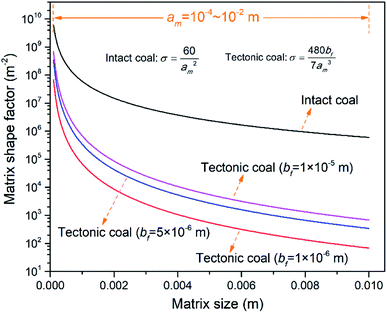 | ||
| Fig. 7 Comparison of the matrix shape factors of intact coal and tectonic coal with different fracture apertures. | ||
According to eqn (9), the diffusion capacity is affected by two parameters: the diffusion coefficient and the matrix shape factor. The diffusion coefficient depends on the gas properties and temperature, so it is difficult to change. If the matrix size can be reduced, the matrix shape factor can be greatly improved, then the diffusion capacity of methane in the tectonic coal can be enhanced.
5 Conclusions
In this study, we collected the typical tectonic coal samples and conducted secondary forming to obtain the standard tectonic coal specimens. Two specimens were selected and conducted methane permeability tests. Combining the permeability and some assumptions, the ESM of the tectonic coal was proposed. Considering the differences of the ESMs between the tectonic coal and intact coal, we also discussed the variations of the permeability model and the matrix shape factor. Based on the work completed, the following conclusions can be made:(1) The tectonic coal can be idealized as a model containing cubic matrix with square section fractures located at the twelve edges of the matrix.
(2) The permeability has a square relationship with the fracture porosity for the tectonic coal, rather than the cubic relation for the intact coal. The permeability of the tectonic coal is not sensitive to the variation of the fracture, so it is more difficult to change the permeability of the tectonic coal than that of the intact coal.
(3) The new matrix shape factor for the tectonic coal has also been proposed with a value of 480bf/7a3m, which is much smaller than that of the intact coal.
(4) The matrix shape factor of the tectonic coal can be greatly improved by reducing the matrix size, which may be the easiest measure to enhance the methane diffusion capacity.
Conflicts of interest
There are no conflicts to declare.Acknowledgements
This research was supported by the National Natural Science Foundation of China (51674252 and 51974300), the Fundamental Research Funds for the Central Universities (2017CXNL02), the Six Talent Peaks Project in Jiangsu Province (GDZB-027) and a Project Funded by the Priority Academic Program Development of Jiangsu Higher Education Institutions.References
- J. Dong, Y. Cheng, K. Jin, H. Zhang, Q. Liu, J. Jiang and B. Hu, Fuel, 2017, 197, 70–81 CrossRef CAS.
- M. Tutak, Sustainability, 2020, 12, 16 CrossRef.
- S. Lu, Y. Zhang, Z. Sa, S. Si, L. Shu and L. Wang, Energy Sci. Eng., 2019, 7, 1352–1367 Search PubMed.
- M. Tutak and J. Brodny, Energies, 2019, 12, 3840 CrossRef.
- S. Lu, Y. Cheng, W. Li and L. Wang, Int. J. Oil, Gas Coal Technol., 2015, 10, 91–114 Search PubMed.
- J. Dong, Y. Cheng and Z. Pan, J. Pet. Sci. Eng., 2020, 184, 106543 CrossRef CAS.
- Y. Cheng and Z. Pan, Fuel, 2020, 260, 116350 CrossRef CAS.
- S. P. Schweinfurth, Coal-a Complex Natural Resource: An Overview of Factors Affecting Coal Quality and Use in the United States, US Department of the Interior, US Geological Survey, 2003 Search PubMed.
- S. Lu, C. Wang, Q. Liu, Y. Zhang, J. Liu, Z. Sa and L. Wang, Process Saf. Environ. Prot., 2019, 132, 351–366 CrossRef CAS.
- B. Kong, E. Wang, W. Lu and Z. Li, Energy, 2019, 189, 116144 CrossRef.
- J. E. Warren and P. J. Root, Soc. Pet. Eng. J., 1963, 3, 245–255 CrossRef.
- L. H. Reiss, The reservoir engineering aspects of fractured formations, Editions Technip, 1980 Search PubMed.
- Q. Liu, Y. Cheng, H. Zhou, P. Guo, F. An and H. Chen, Rock Mech. Rock Eng., 2015, 48, 1163–1180 CrossRef.
- S. Harpalani and G. Chen, Geotech. Geol. Eng., 1997, 15, 303–325 Search PubMed.
- B. Xu, X. Li, M. Zhao, A.-M. Hu, D. Chen and D. Zhang, Energy Sources, Part A, 2015, 37, 365–371 CrossRef CAS.
- J. Liu, Z. Chen, D. Elsworth, X. Miao and X. Mao, Int. J. Coal Geol., 2010, 83, 446–455 CrossRef CAS.
- J. Dong, Y. Cheng, B. Hu, C. Hao, Q. Tu and Z. Liu, Powder Technol., 2018, 325, 412–419 CrossRef CAS.
- S. Lu, Y. Cheng, W. Li and L. Wang, Int. J. Oil, Gas Coal Technol., 2015, 10, 94–114 CrossRef CAS.
- J. Dong, Y. Cheng and P. Guo, RSC Adv., 2019, 9, 22004–22010 RSC.
- R. Pan, Y. Cheng, L. Yuan, M. Yu and J. Dong, Nat. Hazards, 2014, 73, 531–546 CrossRef.
- Q. Yang and Y. Wang, Meitan Xuebao/Journal of the China Coal Society, 1986, 87–94 Search PubMed.
- Z. F. Yan and H. Ying, J. China Coal Soc., 2013, 38, 205–212 Search PubMed.
- C. Zhang, S. Tu and L. Zhang, Transp. Porous Media, 2017, 119, 1–16 CrossRef.
- S. Wang, D. Elsworth and J. Liu, Int. J. Coal Geol., 2011, 87, 13–25 CrossRef CAS.
- H. Kumar, D. Elsworth, J. Liu, D. Pone and J. P. Mathews, Int. J. Greenhouse Gas Control, 2012, 11, 86–97 CrossRef CAS.
- I. Gray, SPE Reservoir Eng., 1987, 2, 28–34 CrossRef CAS.
- I. Palmer and J. Mansoori, How permeability depends on stress and pore pressure in coalbeds: a new model, SPE Annual Technical Conference and Exhibition, Society of Petroleum Engineers, 1996 Search PubMed.
- J. Shi and S. Durucan, Transp. Porous Media, 2004, 56, 1–16 CrossRef.
- X. Cui and R. M. Bustin, AAPG Bull., 2005, 89, 1181–1202 CrossRef CAS.
- E. Robertson and R. Christiansen, A permeability model for coal and other fractured, sorptive-elastic media. Idaho National Laboratory, INL/EXT-06-11830, 2006 Search PubMed.
- L. Connell, Int. J. Coal Geol., 2009, 79, 18–28 CrossRef CAS.
- L. Connell, M. Lu and Z. Pan, Int. J. Coal Geol., 2010, 84, 103–114 CrossRef CAS.
- A. Mitra, S. Harpalani and S. Liu, Fuel, 2011, 94, 110–116 CrossRef.
- J. Zhou, S. Hu, Y. Chen, M. Wang and C. Zhou, Rock Mechanics Rock Engineering, 2016, 49, 3055–3068 CrossRef.
- C. Mora and R. Wattenbarger, J. Can. Pet. Technol., 2009, 48, 17–21 CrossRef.
- K. Lim and K. Aziz, J. Pet. Sci. Eng., 1995, 13, 169–178 CrossRef CAS.
- K. H. Coats, Implicit compositional simulation of single-porosity and dual-porosity reservoirs, SPE symposium on reservoir simulation, Society of Petroleum Engineers, 1989 Search PubMed.
- H. Kazemi, L. Merrill Jr, K. Porterfield and P. Zeman, Soc. Pet. Eng. J., 1976, 16, 317–326 CrossRef.
| This journal is © The Royal Society of Chemistry 2020 |

